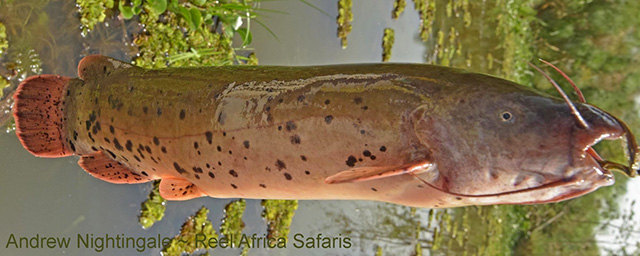| Malapteruridae (Electric catfishes) |
| 122 cm SL (male/unsexed); max.weight: 20 kg; max. reported age: 10 years |
|
benthopelagic; freshwater; pH range: 7 - 8; dH range: 20, potamodromous |
| Africa: typical Sudanian distribution; in much of the Nile system (exclusive of Lake Victoria), Lake Turkana, Lake Chad and Senegal basins, throughout the Niger system and smaller southward flowing basins in west Africa, from Bandama through Volta rivers in Ivory Coast and Ghana (Ref. 44050). Absent from Congo basin; reports from Congo basin refer to any of the other species in this system (see Ref. 44050 for details). |
|
Dorsal spines (total): -0; Dorsal soft rays (total): -0; Anal spines: -0; Anal soft rays: 9-11; Vertebrae: 38-41. Diagnosis: tooth patches narrow; pectoral fin placed near body mid-depth; 7-8 branched caudal fin rays (Ref. 44050). 9-11 anal-fin rays, usually 10-11; 38-41 total vertebrae, usually 39-41 (Ref. 57130). Caudal saddle and bar pattern not present in adults (Ref. 57130), poorly developed in all ages (Ref. 44050). Flank and dorsum in adults and young marked with large blotches (some up to 4-5 times eye diameter); caudal fin of adults generally same color as flank ground color or slightly darker, larger specimens usually with spots or blotches in caudal fin (Ref. 44050, 57130).
Description: body fusiform (Ref. 57130). Head deep and cylindrical; lower jaw only slightly prominent; 16-18 abdominal and 21-24 caudal vertebrae; 19 caudal fin rays (arrangement: ii-7-8-ii) (Ref. 44050, 57130).
Colouration: dorsum tan or occasionally light grey; venter light tan; body bicolored but without sharp demarcation between dorsal and ventral shades; dorsum and flank marked with scattered spots and larger blotches, some as large as 4-5 times an eye diameter; blotching typically denser posteriad, where blotches may merge or overlap; venter usually unmarked, or with a few small spots; small spots usually present on paired fins of specimens larger than 15cm SL; caudal and anal fins well marked with small spots, plus some larger blotches on the caudal fin, in specimens of 15cm SL and larger; caudal fin bears a dusky bar with a pale basal crescent and a clear distal margin; dusky bar is narrow in juveniles and much broader in adults; pale basal crescent may be poorly developed in large adults, with the entire fin pigmented in the flank ground shade; caudal saddle and bar faint in juveniles, with the pale interspace matching the ground color; juveniles show a bar at the caudal fin base, and a less distinct saddle, extending ventrad to the body mid-depth; saddle has disappeared by 10cm SL, caudal bar may persist (faintly) in specimens up to 15cm SL; tiny juveniles (10-20mm SL) are largely unpigmented (Ref. 44050). |
| Occur among rocks or roots. Favors sluggish or standing water. Active at night, feeding mainly on fish stunned by electric shocks. Described as a nocturnal piscivore that breeds during periods of high water; rarely feeds on molluscs (Ref. 44050). The electric organ, capable of discharging 300-400 V, is derived from pectoral muscle and surrounds almost the entire body. It is used both for prey capture and defense. Electric organ discharge (EOD) is intermittent and the amplitude increases with size of the fish (Ref. 10011). Responds immediately to cyclic light changes, exhibiting maximum EOD activity shortly after sunset and lowest activity just after sunrise (Ref. 10798). Its EOD duration decreased from 1.5 to 0.3 ms in response to increased temperature from 15 to 30°C (Ref. 10838). Adults form pairs and breed in excavated cavities or holes (Ref. 7248). Maximum size in Lake Chad reported as 1125mm SL, but most museum specimens much smaller (maximum 400mm SL, Nile River)(Ref. 57130). |
|
Least Concern (LC); Date assessed: 21 October 2019 Ref. (130435)
|
| other |
Source and more info: www.fishbase.org. For personal, classroom, and other internal use only. Not for publication.
